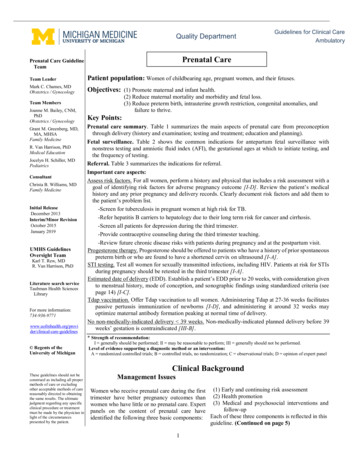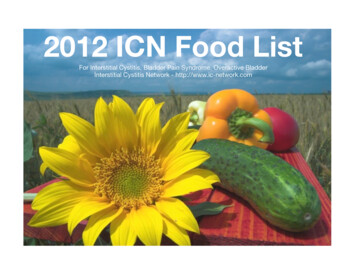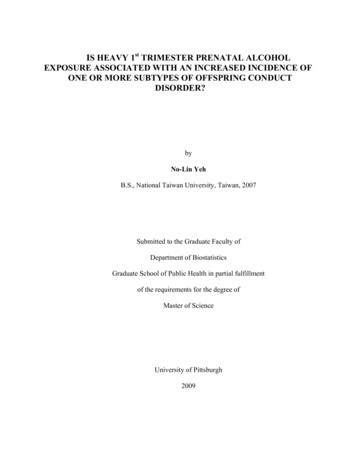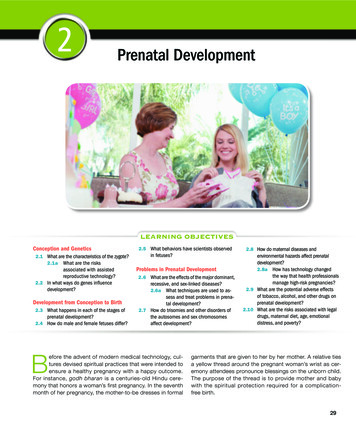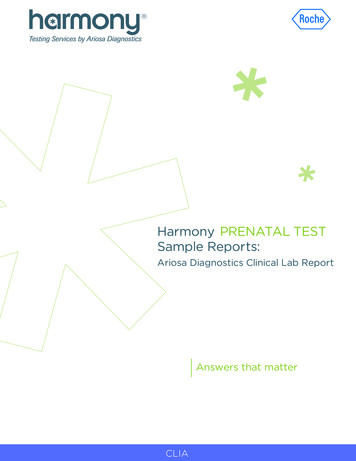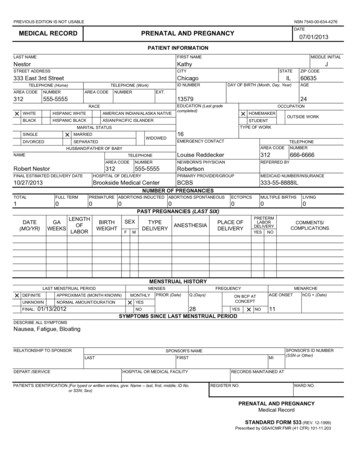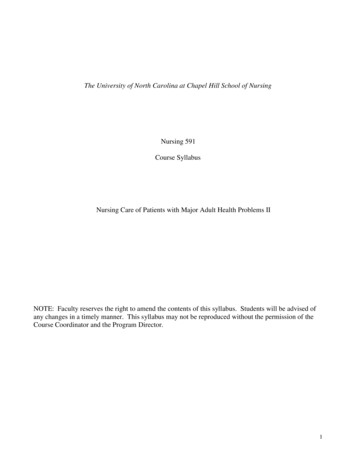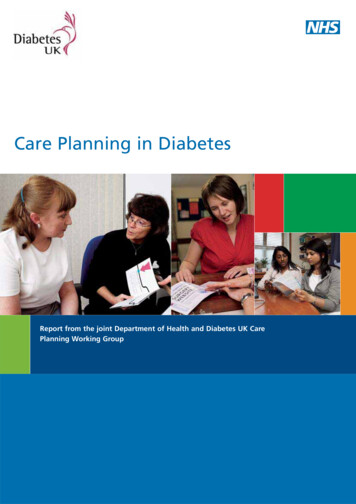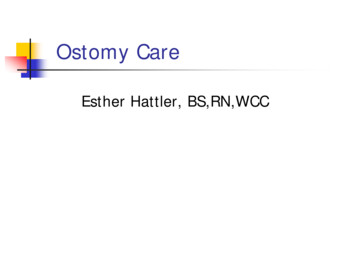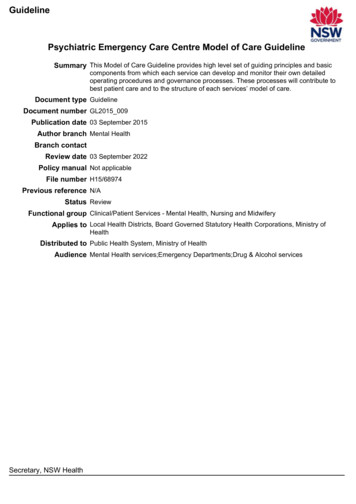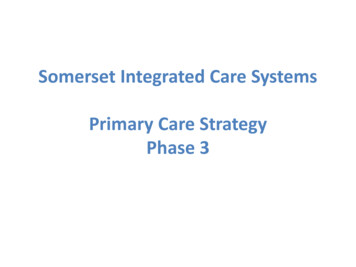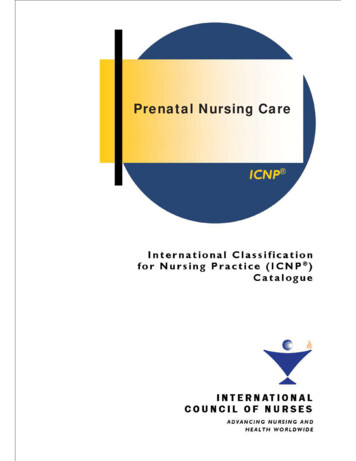
Transcription
Prenatal Nursing Care
Prenatal Nursing CareInternational Classificationfor Nursing Practice (ICNP )Catalogue
All rights, including translation into other languages, reserved. No part of thispublication may be reproduced in print, by photostatic means or in any othermanner, or stored in a retrieval system, or transmitted in any form, or soldwithout the express written permission of the International Council ofNurses. Short excerpts (under 300 words) may be reproduced withoutauthorization, on condition that the source is indicated.Copyright 2017 by ICN – International Council of Nurses,3, place Jean-Marteau, 1201 Geneva, Switzerland2
TABLE OF CONTENTSForeword1Acknowledgements, Contributors, Reviewers2ICNP Catalogues3Purposes3Significance to Nursing3Prenatal Nursing Care Framework4Figure 1: Framework for ICNP Prenatal Nursing CarePrenatal Care ICNP StatementsTable 1: Expected Changes of PregnancyTable 2: Pregnancy at Risk55610References16Bibliography17
FOREWORDApproximately 830 women die every day from preventable causes related to pregnancy andchildbirth (WHO, 2014). Prenatal nurses play a key role in saving lives through early detectionand management of life threatening conditions such as cardiovascular disease, hypertensionand infection. By documenting the ways in which prenatal nurses provide care for pregnantwomen, we can help reduce risk and promote more positive outcomes for both the pregnantwomen and the newborn. This catalogue, specifically aimed at prenatal nursing care,contributes to the reduction of maternal mortality around the world by facilitatingcommunication among health professionals and providing data to examine outcomes andpromote further research.Frances HughesChief Executive OfficerInternational Council of Nurses1
Title: Prenatal NursingCatalogue Type: Terminology SubsetPublication Date: 2016, Updated 2017ACKNOWLEDGEMENTSThe International Council of Nurses (ICN) is pleased to acknowledge the hundreds of nursesand other experts worldwide who contribute to the ongoing development and disseminationICNP .CONTRIBUTORS to this ICNP CatalogueLin Liu, PhD Candidate, RNLecturer, College of Nursing, Second Military Medical University, Shanghai, ChinaAmy Coenen, PhD, RN, FAANDirector, ICNP Programme, International Council of NursingProfessor, College of Nursing, University of Wisconsin-Milwaukee, Wisconsin, USHong Tao, PhD, RNAssistant Professor, College of Nursing, University of Wisconsin-Milwaukee, Wisconsin, USKay R. Jansen, DNP, PMHCNS-BC, RN, CNEClinical Associate Professor, College of Nursing, University of Wisconsin-Milwaukee,Wisconsin, USAnli Jiang (Corresponding author), Med, RNProfessor, College of Nursing, Second Military Medical University, Shanghai, ChinaNote: Creation of this catalogue was a group endeavour. Author order does not indicateamount of contribution.REVIEWERS of this ICNP CatalogueMary Jo Baisch, PhD, RN, Associate Professor Emerita, College of Nursing, University ofWisconsin-Milwaukee, Wisconsin, USClaudia C. Bartz, PhD, RN, International Society for Telemedicine and eHealth, Chair,Telenursing Working Group, Wisconsin, USSaori Fujimoto, RN, NM, PHN, PhD, Midwifery and maternal-Newborn Nursing, Division ofNursing Science, Graduate School of Biomedical & Health Sciences at Hiroshima University,JapanLisa Mihlbauer MS, RN, IBCLC, CNEClinical Associate Professor, College of Nursing, University of Wisconsin-Milwaukee,Wisconsin, US2
ICNP CATALOGUESThe International Classification for Nursing Practice (ICNP ) is a unified nursing languagesystem that supports the standardisation of nursing documentation at the point of care. Theresulting data-based information can be used for planning and managing nursing care,financial forecasting, analysis of patient outcomes and policy development. The ICNPStrategic Advisory Group and many other expert nurses involved with ICNP have recognisedthat manageable subsets of the terminology should be available to nurses working withpatients or clients in selected specialties and settings.Catalogues are subsets of ICNP that allow nurses to more readily integrate ICNP into theirpractice as they work in a specialty area or with clients having specific health conditions orneeds.Catalogues do not replace the clinical judgement of the nurse. Nurses can use catalogues asreference tools for documenting care and reflecting on their practice. Nurses’ clinicaljudgement and decision-making are essential for individualised care of patients and theirfamilies and cannot be replaced by any tool.PURPOSESThe purposes of this catalogue are to facilitate: Documentation of nursing practice by nurses providing care for pregnant women; Articulation of prenatal care nursing practice; Description, retrieval, comparison, and reuse of data to evaluate quality of nursingcare and to direct policy.The clients for prenatal nursing care include pregnant women and families. Pregnant womenare the population addressed in this project. The prenatal period is the time betweenconception and onset of labour (Davidson et al. 2012). This ICNP catalogue focusesspecifically on the provision of prenatal nursing services worldwide.SIGNIFICANCE TO NURSINGMaternal mortality rates around the world are unacceptably high. Approximately 800 womendie each day from complications of pregnancy and childbirth (WHO, 2014). Many of thesedeaths are preventable. When conditions such as cardiovascular disease, hypertension, andinfection are detected and managed early in a woman’s pregnancy through prenatal care,life-threatening complications can be averted (WHO, 2014). Goal 5 of the United NationsMillennium Development Goals (MDG) is to improve maternal health. Since 2000, progresshas been made toward achieving the goal of universal access to prenatal care, however, onlyhalf of pregnant women receive the level of care that is recommended (United Nations,2015).3
Nurses can contribute to quality outcomes for pregnant women and their infants.Documentation of nursing care during the prenatal period can facilitate communicationamong all health professionals involved and provide data to examine outcomes and promotefurther research.PRENATAL NURSING CARE FRAMEWORKThe nursing diagnoses, interventions and outcomes in this Catalogue are organised in twocategories: Expected Changes of Pregnancy and Pregnancy at Risk. Each category includesfour sub-categories. The Expected Changes of Pregnancy category includes Physical,Psychosocial, Behavioural changes, and Knowledge. The Pregnancy at Risk categoryincludes Physical, Psychosocial, Behavioural, and Environmental risks. Each category hasunique nursing diagnoses, interventions and outcomes. See Figure 1.Expected Changes of PregnancyBecause pregnancy is a normal process, a pregnant woman is typically able to manage mostof the problems or issues that occur with some support from healthcare providers. Mostwomen progress through pregnancy without complications, requiring little specialised medicalor nursing intervention, yet prenatal care is essential for the health and well-being of both thepregnant woman and the developing fetus.The Expected Changes of Pregnancy category includes problems or issues that occur duringhealthy pregnancies. The nursing interventions in this category focus primarily onsurveillance, support, and education. The prenatal nurse monitors the health status of themother and foetus, provides emotional support, and teaches the pregnant woman and herfamily about physiological and psychological changes during pregnancy, foetal development,labour and childbirth, and care for the newborn.Pregnancy at RiskThe second category in the Catalogue organising framework is Pregnancy at Risk. Thiscategory includes the nursing diagnoses, interventions and outcomes for pregnant womenwho need additional healthcare provider interventions to manage problems or issues that areor may contribute to pregnancy complications.According to the Centers for Disease Control and Prevention (2014), the most severecomplications of pregnancy affect more than 50,000 women in the United States every year.These women need additional nursing care and support based on the seriousness of the riskor disease. Some prenatal related symptoms, such as anemia, bleeding, infection, andvomiting, are more common and require medical intervention. Other, more seriouscomplications, for example preeclampsia and eclampsia, can be fatal. The statistical data ofthe Global Burden of Hypertensive Disorders of Pregnancy revealed that 2.3% of allpreeclampsia cases resulted in eclampsia, and these hypertensive disorders are responsiblefor 13% of maternal deaths (Christian & Krumwiede, 2013).4
Early detection and identification of pregnant women at risk for complications is essential.Nursing interventions to reduce risk can promote more positive outcomes for both thepregnant women and the newborn.Figure 1: Framework for ICNP Prenatal Nursing Care Diagnoses, Interventions, andOutcomesICNP Prenatal NursingCare CatalogueExpected changesof pregnancyPregnancy at ksKnowledgeEnvironmentalrisksPRENATAL NURSING CARE DIAGNOSTIC, OUTCOME ANDINTERVENTION STATEMENTSThis Catalogue fills a practical need by listing ICNP statements for diagnoses, outcomes andinterventions for nursing care of pregnant women. The list provided below aims to becomprehensive but it is understood that the list does not exhaust the domain. The diagnosticand intervention statements are intended to be examples only and are not intended to beprescriptions for practice. Catalogues cannot replace the clinical judgement of theprofessional nurse.In ICNP, nursing diagnoses may include either a positive asset or a problem condition of aclient or patient. Nursing outcomes are the measure or status of a nursing diagnosis at pointsof time after a nursing intervention (ICN, 2008). Nursing Diagnoses and Outcomesstatements could be documented in the client’s health record according to how they are usedin practice. For example, effective gastrointestinal system function may be identified by thenurse as either a diagnosis or outcome statement.5
ICNP Catalogue: Prenatal Nursing CareTable 1. Expected changes of PregnancyNursing diagnosisNursing interventionNursing outcomesPhysical changesImpaired breathing10001316Teach breathing technique10039213Effective breathing10041334Breast tenderness10046676Teach about breast careduring prenatal period10032892Promote exercise10040834Administer medication10025444Teach about diet10046533Encourage rest10041415Teach about diet10046533Assess fatigue10026086Measure foetal heart rate10043440Measure foetal movement10043455Teach about perineal care10045165Administer medication10025444Teach about diet10046533Encourage rest10041415Administer medication10025444Teach about diet10046533Teach about diet10046533Administer medication10025444Monitor weight10032121Teach about diet10046533Reduced ective foetal development10045718Haemorrhoids10043279Leg rweight100273166Effective defaecation10028403Reduced fatigue10029390No fatigue10034727Effective foetaldevelopment 10045718Symptom control10025820Pain control10025831No nausea10028984Weight within normal limits10027392
ICNP Catalogue: Prenatal Nursing CareTable 1. Expected changes of PregnancyNursing diagnosisNursing interventionNursing outcomesPhysical changesPain10023130Manage pain10011660Heartburn10043298Teach about diet10046533Peripheral oedema10027482Manage oedema10036793Teach about fluid intake10032939Apply elastic stockings10030486Teach about fluid intake10032939Promote hygiene10032477Teach about perineal care10045165Promote oral hygiene10032483Teach about fluid intake10032939Administer medication10025444Administer medication10025444Promote hygiene10032477Teach about perineal care10045165Monitor vaginal discharge10046372Teach about vaginal hygiene10043438Urinary frequency10046695Vomiting10025981Excess vaginal discharge10043331Pain control10025831Reduced pain10027917No pain10029008Effective gastrointestinalsystem function10028016No peripheral oedema10029020Effective urinary systemfunction10028615No vomiting10029181No infection10028945Psychosocial changesDisturbed body image10001079Employment problem10029841Assess body image10045891Support positive body image10044531Advise about employment10030440Labile moods10045652Manage mood100362567Positive body image10028564Positive psychologicalstatus10038430Mood equilibrium10035792
ICNP Catalogue: Prenatal Nursing CareTable 1. Expected changes of PregnancyNursing diagnosisNursing interventionNursing outcomesPsychosocial changesFear10000703Assess fear10024267Counsel about fears10026208Risk for impaired familycoping10032364Assess family coping10026600Support family copingprocess10032859Assess depressed mood10026055Risk for depressed mood10032329Anxiety10000477Readiness for effectiveparenting10001521Readiness for positive familyprocess10001482Assess anxiety10041745Teach relaxation technique10038699Teach breathing technique10039213Assess readiness to learn10002781Promote effective parenting10032496Assess readiness to learn10002781Prepare child for sibling role10045495Teach about family process10036153Reduced fear10027889Positive psychologicalstatus10038430Effective family coping10034770Decreased depressedmood10027901Reduced anxiety10027858Effective parenting10027955Effective family process10025232Behavioural changesImpaired exercise behaviour10022043Impaired sleep10027226Restlessness10025722Risk for fall10015122Teach about exercise10040125Promote exercise10040834Assess exercise behaviour10024251Teach about sleep10040380Encourage rest10041415Assess balance10037457Fall prevention100402118Knowledge of exercise10023786Adherence to exerciseregime10030163Adequate sleep10024930Symptom control10025820No Fall10034704
ICNP Catalogue: Prenatal
These women need additional nursing care and support based on the seriousness of the risk or disease. Some prenatal related symptoms, such as anemia, bleeding, infection, and vomiting, are more common and require medical intervention. Other, more serious complications, for example preeclampsia and eclampsia, can be fatal. The statistical data ofFile Size: 881KBPage Count: 23
